About Kavi Ji & 'Garab Ganjanee' Introduction
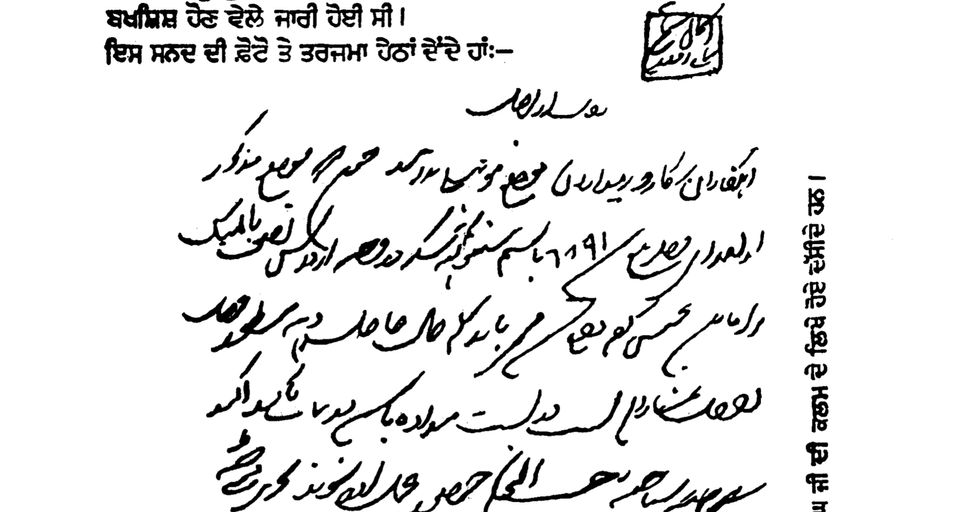
ੴ ਸਤਿਗੁਰਪ੍ਰਸਾਦਿ
This is a humble effort at translating the great Sri Japji Sahib commentary written by Mahakavi Bhai Santokh Singh Ji: ‘Garab Ganjanee’ Teeka. This is a granth originally written for scholars so it is not meant for beginners but we hope to add enough context required to navigate through this masterpiece. This is the first SikhTranslations project under the guidance of many Gursikhs. We are patiently translating, editing, and proofreading for the Sangat to read a high-quality translation. If you see any errors, please contact us so we can make corrections.
Many thanks to Ustaad Giani Harman Singh Ji (Basics of Sikhi), respectworthy Giani Jivanpal Singh Ji UK, Giani Supreet Singh Ji US, Bhai Simandeep Singh Ji (Gursevak), Bhai Upkaar Singh Ji, Bhai Abheet Singh Ji, Bhai Jasneet Singh Ji for their ongoing seva in this project. Special thanks to Bhai Kamalpreet Singh for uploading the Garab Ganjanee Teeka on Gurmatveechar.com. Another special thanks to Sri Guru Granth Sahib Academy for producing an easy to understand Punjabi version of Garab Ganjanee Teeka which is heavily being relied on in this translation.
Millions of Namaskaars towards the Blossoming Lotus-Feet of Dhan Dhan Guru Nanak Dev Sahib Ji for blessing us with such Gurbani as even hundreds of human lifetimes will not be able to find a limit to the meanings of Akaal Purakh’s Priceless Bani.
Guru Panth Ka Daas,
Aaeenaa
Note: The following translation is an arrangement of different excerpts from the introduction of the 1986 Gurmukhi version of Garab Ganjani teeka/commentary. The original authors of this introduction include the likes of Giani Khajaan Singh and Professor Piara Singh Padam.
Note 2: Bikrami is the traditional Indian calendar and CE refers to Common Era in our commonly used Gregorian calendar.
Brief Biography about Kavi Ji
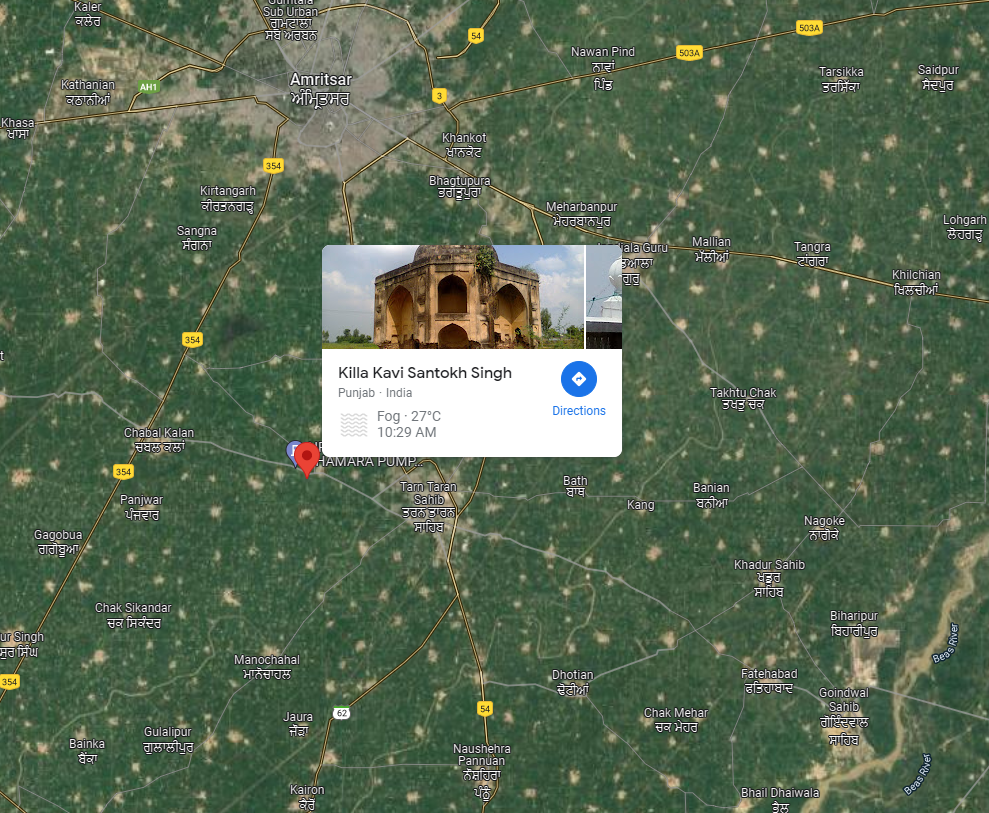
Kavi Ji was born to Mata Rajaadhee (ਮਾਤਾ ਰਜਾਦੀ; Raaj Devi) and respectworthy Sardar Deva Singh Ji on 7 Asu (11 Vadhee) Sammat 1844 Bikrami/1787 CE. Kavi Ji was born in a village called Sarai Noor Deen (ਸਰਾਇ ਨੂਰ ਦੀਨ; now called Kila Kavi Santokh Singh). This village is 4.75 miles/7.64km away from Sri Tarn Taaran Sahib. Located by the main road from Sri Tarn Taaran to Lahore.
Receiving Vidhya at Sri Amritsar Ji
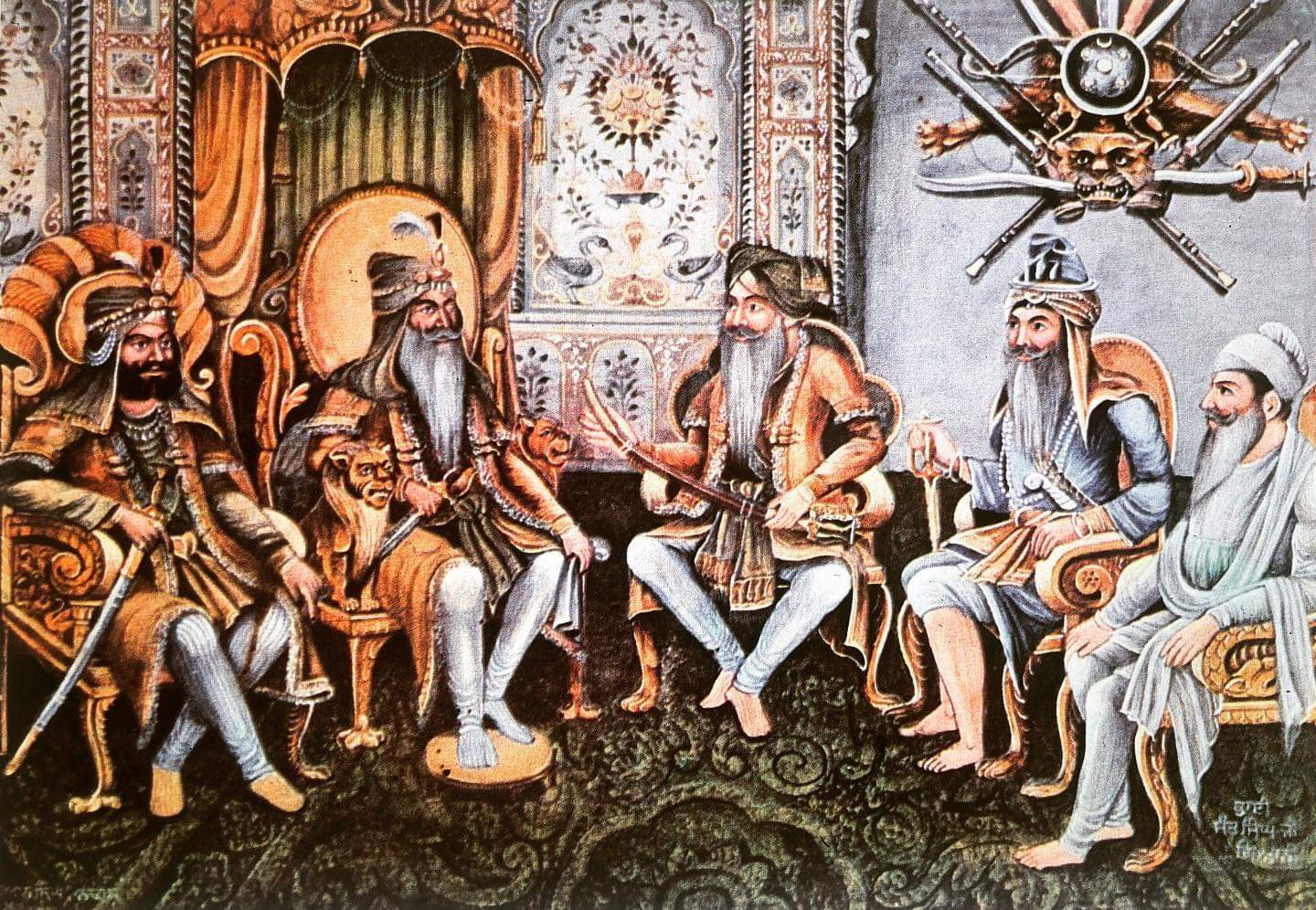
Kavi Ji’s father was also quite knowledgeable. In 1855 Bik/1798 CE, Sardar Deva Singh Ji had sent Kavi Ji to learn Gurmat Vidhya and the Art of Poetry from the Great Pandit & Head Sevadaar at Sri Harmandhir Sahib - Sri Maan Giani Sant Singh Ji. During this time, Kavi Ji reflected on the meanings of Gurbani, engrained Guru Sahib’s values, and instilled many skills as part of his Gurmat fulfillment. In 1865 Bik/1808 CE, Kavi Ji went to Kaanshi, where Kavi Ji showed his poetic skills and enamoured the pandits there. In exchange, the Pandits passed on great skills/qualities to Kavi Ji.
Staying in the Boorreeaa Kingdom and Commitment to Spiritual Practice
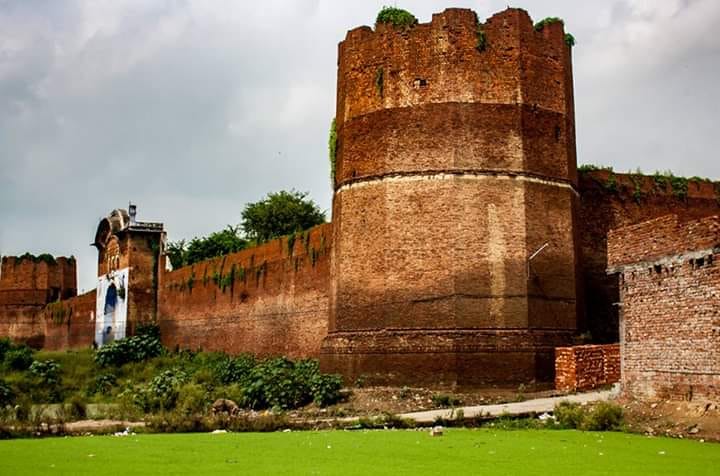
In 1870 Bik/1813 CE, Kavi Ji became a court poet of the Boorreeaa/Buria Kingdom (ਬੂੜੀਏ). Here Kavi Ji received much respect and honour. Kavi Ji developed a strong desire to praise the Guru Sahibaan and write Their Beloved History. In order to gain spiritual strength and divine blessings, Kavi Ji went to a nearby village called Dhiaal Garh. Kavi Ji sat on the historic stairs at the banks of the Yamuna River. Here Kavi Ji went into Samadhi/deep meditation and concentrated his mind on the Simran/remembrance of Akaal Purakh. They kept doing the following Ardaas:
“Oh Vaheguru, please bless me with the strength of praising the Guru Sahibaan and to be able to write the Guru Sahibaan’s History.”
Kavi Ji spent 5 years in these spiritual efforts. On this saintly journey, Kavi Ji received the blessing of this desire.
Naam Kosh and Sri Guru Nanak Prakaash
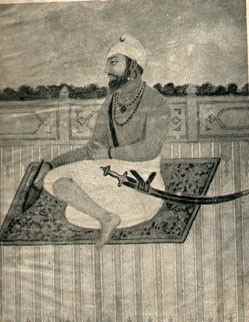
Kavi Ji began writing in 1875 Bik/1818 CE. Naam Kosh was Kavi Ji's first granth This is what can be described as a Sanskrit encyclopedia. While working on Naam Kosh, Kavi Ji searched for stories attached to Satguru Nanak Dev Ji Maharaj. In 1878 Bik/1821 CE, Kavi Ji finished writing Naam Kosh at Sri Amritsar Ji. On Kathak Sudhee Pooranmaashi 1880 Bik/1823 CE, the first poetic epic granth Sri Guru Nanak Prakaash became complete. In this same year, Kavi Ji broke the entanglement of caste-lineage and married Bibi Raam Kaur of Jagadhri. Also during this year, the King of Patiala: Maharaja Karam Singh Ji called Kavi Ji to his court. Here, Kavi Ji was honoured and given immense respect. Kavi Ji was provided an elegant haveli [mansion] to stay in, nice food, and an allowance.
Staying at Kaithhal Kingdom and Writing Other Granths
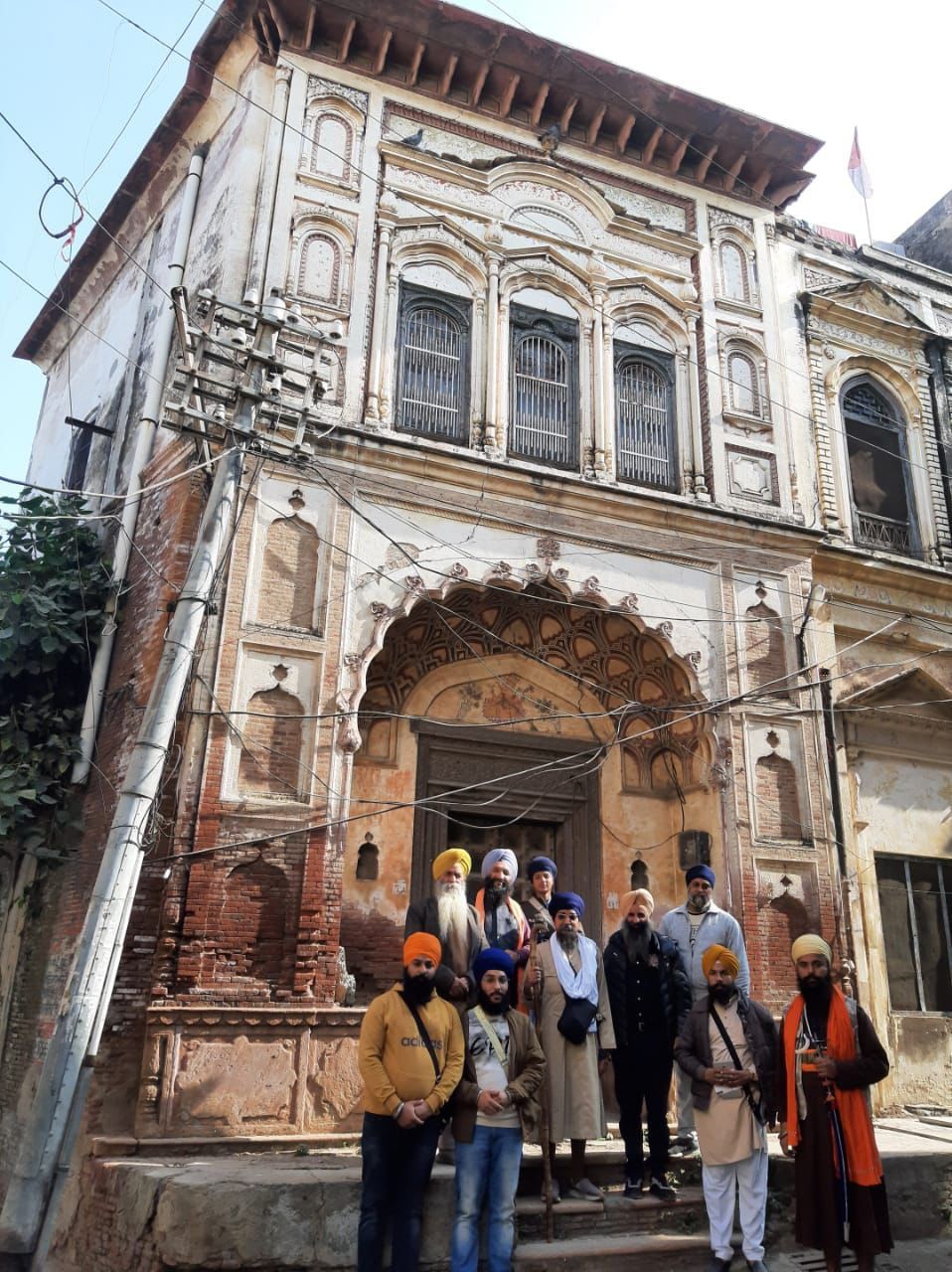
Bhai Udhai Singh Ji, King of Kaithhal, was known to honour scholars and great poets. After hearing many praises about Kavi Ji, Raja Ji requested his presence in 1882 Bik/1825 CE. Being known as a royal poet, Kavi Ji was given a haveli [mansion] called Shera Wali near the Brahmin neighborhood. Kavi Ji was also provided an elephant to ride on. Raja Ji had stated:
Kavi Sahib, I will take responsibility to cover all costs associated with your residence here and writing the history of the Guru Sahibaan. Please start this great task without any worries.
The Creation of Gur Prathaap Sooraj Granth
After completing the history of Guru Nanak Dev Sahib Ji Maharaj, Kavi Ji wanted to complete writing the history of the remaining 9 Guru Sahibaan. Raja Sahib and Kavi Ji put in a lot of effort to fulfill such a great task. However, there were obstacles in this project due to not finding certain stories. Maharaj blessed them so gracefully when a Gursikh came to stay a night at Kavi Ji’s home. Upon waking up in the morning to check up on the Gursikh, Kavi Ji found that he had disappeared from the room. Even after heavy searching, they could not find him. He left his bag in the room he stayed in. While going through the Gursikh’s bag, all of the missing stories were found in writing. Kavi Ji was wonderstruck after finding this:
“Bhayo Achaanak Sa[n]chy Aaee; Sarab Guran Ko Jas Samudhaaee”
Suddenly the collection came, All of the Guru’s Praises were gathered within it.
Seeing this as supernatural help from Akaal Purakh, Kavi Ji was encouraged to continue this task wholeheartedly. Unfortunately, the compassionate Raja Sahib did Akaal Chalaanaa [merged with Vaheguru] after a majority of the task was completed and there was just a little bit left. Kavi Ji came under stress and started doubting the completion of this task. Some friends advised Kavi Ji to seek the support of another Raja but Kavi Ji said:
“Ab Aur Kee Aas niraas Bhaee, Kalgidhhar Baas Keeo Man Maahee”
Any hope I sought from others is lost, so I am hopeless,
Sri Guru Gobind Singh Sahib Ji, please reside in my mind
Then Kavi Ji gathered his mind back to the Lotus-Feet of Guru Sahib and did a humble yet honest ardaas. After some time went by in doing these Benti’s (pleas) then Kavi Ji received Darshan/sight of Guru Sahib and a Hukam:
“Oh Gurmukhaa! Keep the pen flowing, Akaal Purakh will be of help!”
Kavi Ji took this event on as Divine motivation and put his efforts toward this task once more. Truly, Sache Paatshah/True Emperor worked through Their Sevak/Servant to get this task done. This great poetic masterpiece called Gur Prathaap Sooraj Granth was completed in the month of Saavan, 1900 Bik/1843 CE.
Following this, Kavi Ji wrote about the Stories of Sri Guru Gobind Singh Ji, Sri Guru Ustathee/Praise of Guru Sahibaan, Prashan Vidhhee/Inquiry Technique, Ghar Banaun Vidhee/Technique to build a house, along with 5 other smaller granths.
If you wish to be guided through Sooraj Prakaash, please find our translated table of contents here
Garab Ganjani Context
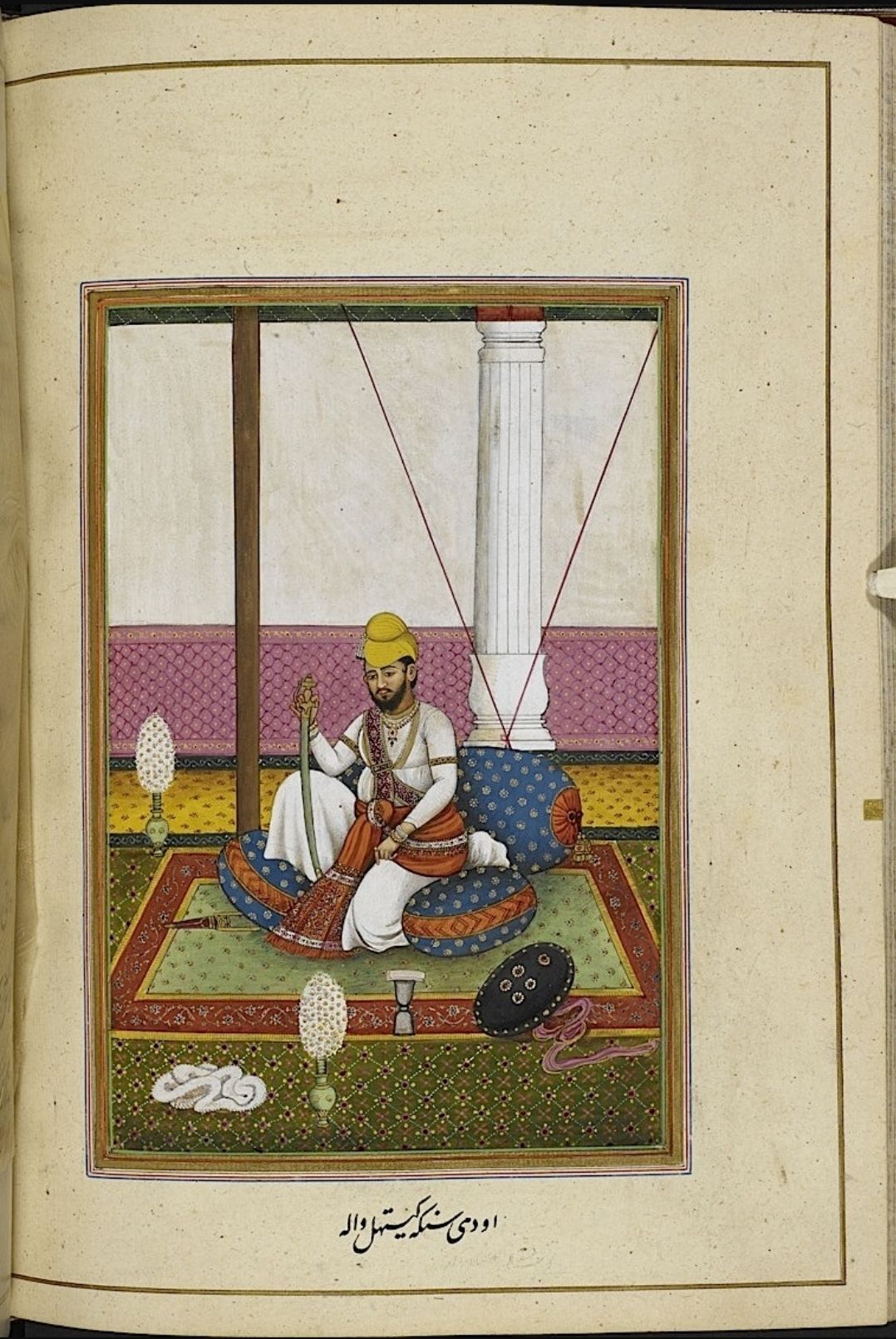
In the time of Mahakavi Bhai Santokh Singh Ji (ਮਹਾਂਕਵੀ ~ Great Poet), there was a well-studied sadhu (ਸਾਧੂ ~ holy man) named Anandghan who wrote a few commentaries on Gurbani. Anandghan’s Japji Sahib commentary was brought forward to the honourable Maharaja Udhai Singh of Kaithhal. Maharaja Ji read it and noticed that the writer created many doubts about Gurbani. Anandghan wrote things that were faith-breaking and against the true interpretation & essence of Gurbani. Maharaja Ji gave this pothi to Kavi Santokh Singh Ji in order to hear his thoughts about this commentary. Kavi Ji had stated that Anandghan had just written his own personal interpretation of Gurbani and seemed like he did not study the meanings from a Giani/Spiritually-Knowledgeable Person. Kavi Ji has written about this event at the beginning of his own commentary and how Maharaja Ji commanded Kavi Ji to write a Sri Japji Sahib commentary of his own. This commentary would remove any doubts that the doubters have created. In this proposed commentary, answers should be given to the questions that had been created by Anandghan. Kavi Ji was tasked to develop a better Gurbani commentary through the use of his keen intellect and poetic knowledge. Following this command, Kavi Ji began writing this teeka/commentary.
Upon the request of Maharaja Udhai Singh, Kavi Ji wrote this teeka and Anandghan’s clever arguments are broken and his doubts arre responded to. Through Kavi Ji’s own spiritually-backed reasoning, proper arths of Gurbani are presented. Between the arths, Kavi Ji analyzes each Gurbani line through literary devices. This is the only teeka that exemplifies the poetic beauty of Gurbani.
Kavi Ji named this teeka ‘Garab Ga[n]jnee’ (ਗਰਬ ਗੰਜਨੀ). What does this name mean? At the end of this teeka, Kavi Ji fully explains the reasoning. The meaning of the words Garab Ganjani: ‘The [One] who breaks the ego/hungkaar’. The intention behind this is as follows: if any scholar does arth/explains meanings of Gurbani through their own pride then their ego will go away through reading this teeka. A second arth/meaning: whoever reads this should remove their ego/hungkaar, they should take on the virtues of Gareebi (ਗਰੀਬੀ) and humility. This will allow them to walk on the truthful path of liberation.
Kavi Ji caters his arth’s/meanings towards contemporary Vedant-oriented scholars. During this time, people would be considered smart and clever if they could take a worldly concept and transition into discussing Vedantic concepts. Even where the meaning of something is specifically about Bhagti/spiritual devotion, it would often be turned into Vedantic discussions by scholars. This was considered a special skill.
Majority of the available granths by Mahakavi Bhai Santokh Singh Ji are written in the form of poetry. For example: Naam Kosh, Gur Nanak Prakaash, Gur Prathaap Sooraj Granth, and Vaalmiki Ramayan. However, this Japji Sahib commentary is written in prose. Aatam Puraan teeka is said to have been also written in prose but it’s not available to us today (was not published). This commentary was written in Saadhhu Bhaashaa. Scholars used to particularly write and recite in this language during Kavi Ji’s time. So, it made sense for Kavi Ji to write in this language.
Besides Sri Gur Nanak Prakaash and Sri Gur Prathaap Sooraj Granth, Kavi Ji’s other writings did not get widely published. Garab Ganjani Teeka was published 50 yrs later yet a published version is hard to find even today.
Legacy
It is rare to find a perfect example of Punjab’s 19th century’s great cultural sevadaars. Among them, there was the Teg-da-Dhani (ਤੇਗ ਦਾ ਧਨੀ) (lit. wealthy with the sword)-Maharaja Ranjeet Singh, and the second is Kalam-da-Dhani (ਕਲਮ ਦਾ ਧਨੀ) (lit. wealthy with the pen)-Mahakavi Bhai Santokh Singh. Ranjit Singh’s reign has ended but the sun has not set on [Bhai] Santokh Singh’s literary empire. The amount of hard work and effort put into being a great poet and historian is unparalleled. During that time, the diamond among poetic languages was Brij-Bhaashaa or Hindi. Punjab’s scholars thought it was a proud feat to be able to compose in these languages. So, to carry out the task of writing about the enlightening mission of the Guru Sahibaan in this language was much needed. Kavi Ji wrote with full skill as he took a hard-to-read topic – such as history – and made it colourful and alluring. This was not just history being written but an exemplary literary masterpiece.
Besides being a historian and mahakavi, Kavi Santokh Singh was a great pandit of Indian spiritual granths. Among the poetry and history, Kavi Ji also makes deep references to Gurmat spiritual concepts. This is a piece of evidence of his greatly detailed scholarship. In Sri Nanak Prakaash and Gur Prathaap Sooraj Granth, whenever the Guru Saahibaan are in dialogue with Peer’s, Fakeer’s, Sidhh’s, Yogi’s, Pandit’s, Maulana’s; Kavi Ji takes advantage of these scenarios by explaining concepts from those traditions in context to Gurmat. For example, in Sri Nanak Prakaash Poorbaardhh (Adhiyaye 48-49), Kasht Yog and Bhagti Yog are explained to show the importance of prema bhagti/loving devotion. In the same manner, Hatt Yog is denounced (adhiyaye 60-64). In Sri Nanak Prakash’s 51st Adhiyaye, Guru Nanak Dev Sahib Ji gave teachings to Bhai Lehna Ji. In this section, Vedant’s spiritual knowledge is condensed into this dialogue. Just like this, there are many other examples of Kavi Ji’s knowledge spread out within Sooraj Prakaash.
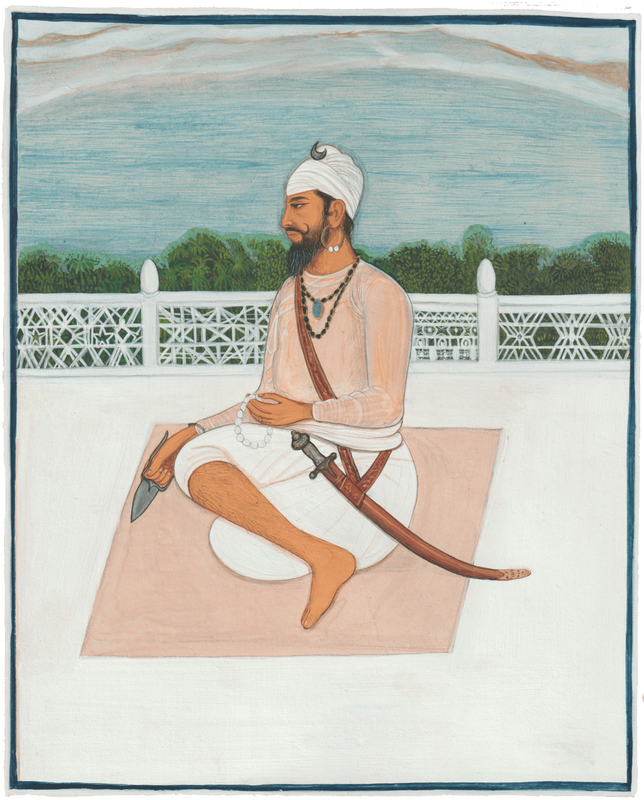
In this way, wherever Kavi Ji was fully knowledgeable in the wisdom of spiritual concepts, he was also knowledgeable in ancient literature. The proof of this is found in the Japji Sahib Teeka ‘Garab Ganjani’. In this teeka, Gurmat principles are explained based on the popular shaastri methods of that time. In addition to this, Sri Japji Sahib’s poetic greatness is presented through miraculous literary devices and Kavi Ji’s unique literary glow.
In each Pauree of Japji Sahib, Kavi Ji sees the poetic colours and paints us the beauty of Gurbani. Kavi Ji presents us with the poetic admiration of Gurbani through discipline and saintliness. This is proof of great scholarship.
It is important to comment on the language of this teeka. This teeka is written in Gadh and Sant Bhaashaa. Just like poetry was written in Brij-Bhaashaa at that time, prose was written in Sadhu-Karree (ਸਾਧੂ-ਕੜੀ) or Sadhu Bhaashaa (ਸਾਧੂ-ਭਾਸ਼ਾ; the most popular language of the time). Pandits and sadhus used this language commonly for spiritual and religious discussions. This is why Kavi Ji wanted to present the principles and literary greatness of Japji Sahib to these groups of people. Based on the necessity of that time, Kavi Ji was able to merge his poetic and scholarly knowledge in a beautifully presented way for those who could comprehend such deep discussion. In this commentary, every line is explained in many different ways. From this point, we understand that this teeka was written for scholars who have different spiritual perspectives (even if Guru Sahibaan only had one intention for the specific line).
Besides all of these aforementioned reasons, this teeka is an example of Kavi Ji’s prose, which is worth preserving on its own. Even if Kavi Ji wrote Aatam Puraan in prose, its manuscripts have never been completely found yet. This is why Garab Ganjani teeka’s spiritual and religious discussion is of most benefit to us.
Kavi Ji’s Final Visit to Sri Amritsar Ji and Akaal Chalaanaa
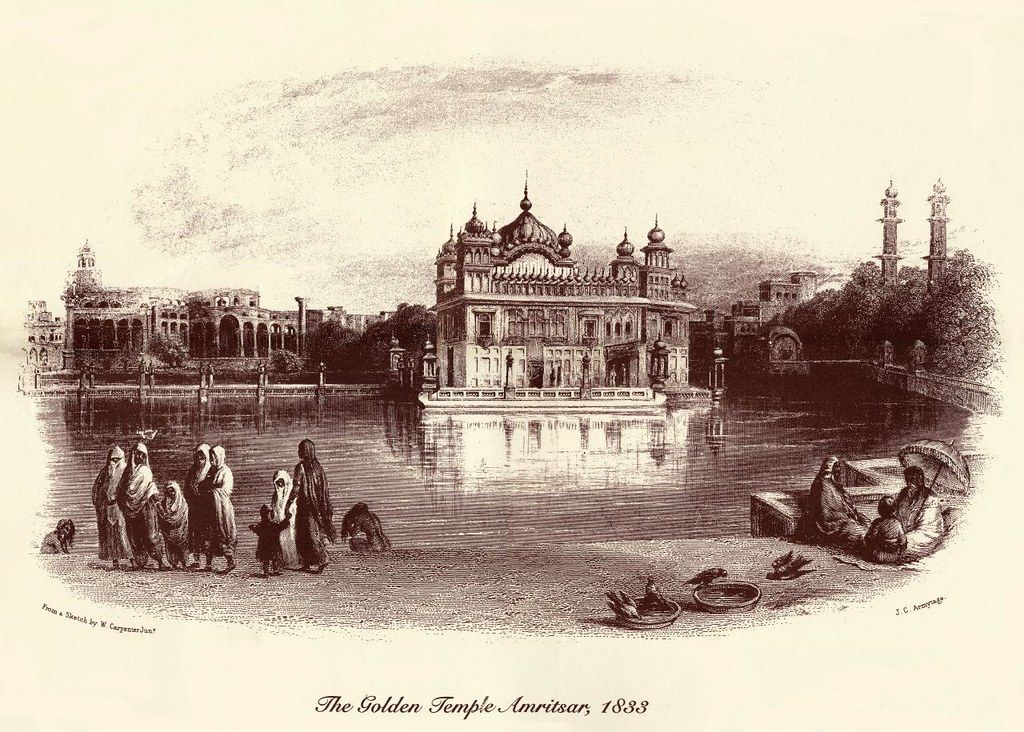
In Asu 1900 Bik/1843 CE, Kavi Ji took his son Bhai Baldev Singh, the rest of his family, and his Ustaad’s son - Giani Gurmukh Singh Ji to Sri Amritsar Sahib. Kavi Ji came to Sri Akaal Takht Sahib and presented his life’s work Sri Guru Nanak Prakaash and Gur Prathaap Sooraj Granth. Kavi Ji requested to the Ardasiya Singh to do the following Ardaas:
“Through the Blessing of Satguru Ji, daas was able to do this little seva. May it be accepted in the Court of Akaal Purakh. May the Panth bless me with happiness and may my Faith in Sikhi be maintained through each of my breaths and every Kes on my body (Sikhi Kesaan Suaasan Naal Nibhae)”
The Ardasiya Singh completed the Ardas and Kavi Ji was awarded a Siropa. The granths were given to Giani Gurmukh Singh.
Kavi Ji went back to Kaithhal with his family. Kavi Ji was that pure soul which remain connected to Guru Sahib’s Lotus Feet. In Kathak Vadhee 11 1900 Bik/1843 CE, Kavi Ji permanently went to the Laps of Guru Sahib. However, Kavi Ji was satisfied with leaving this world after completing such a great task with the blessings of the Satguru Sahibaan and being able to offer the collective granth to Sri Akaal Takht Sahib.
Kavi Ji’s Sacrifice and the Panth’s Responsibility
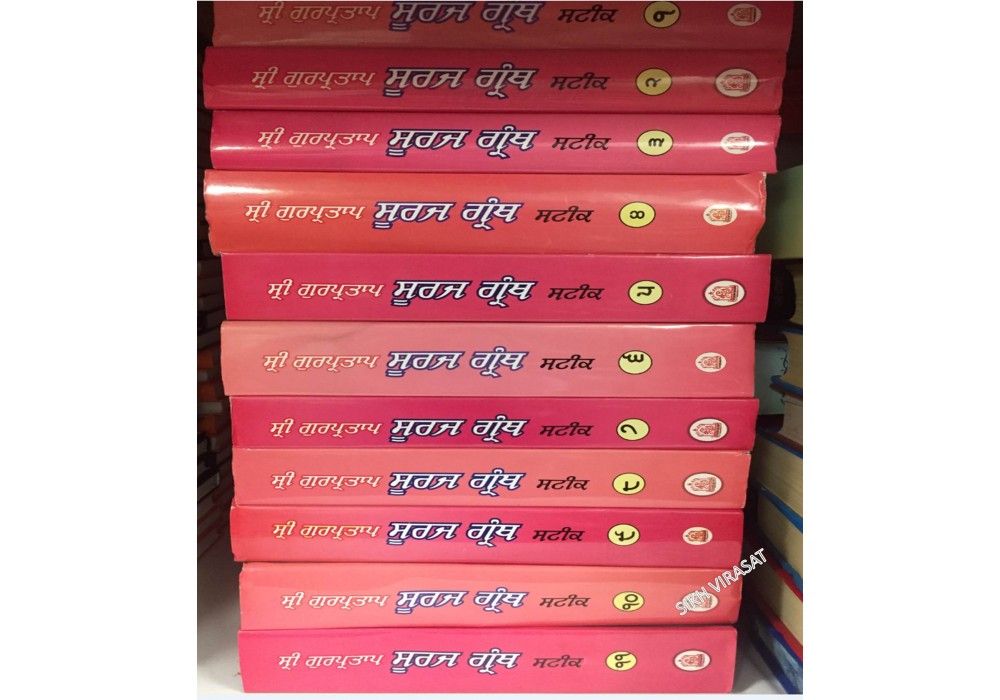
Kavi Ji used almost all of the poetic forms in his writings and that too in such a beautifully arranged manner. Kavi Ji was able to supercede South Asia’s other great poets by writing with such faith, love, and trust within 14 Volumes, 6000 Pages, 62000 Chhands, and 225000 lines. Kavi Ji did not have a registry for himself or his family, nor made any type of copyright. We have some responsibility to keep the memory of such a Mahapurakh alive. We should at least celebrate Kavi Ji’s day of birth or barsi every year. A diwan should be arranged in order to do katha of Kavi Ji’s life and remember his benevolence.

